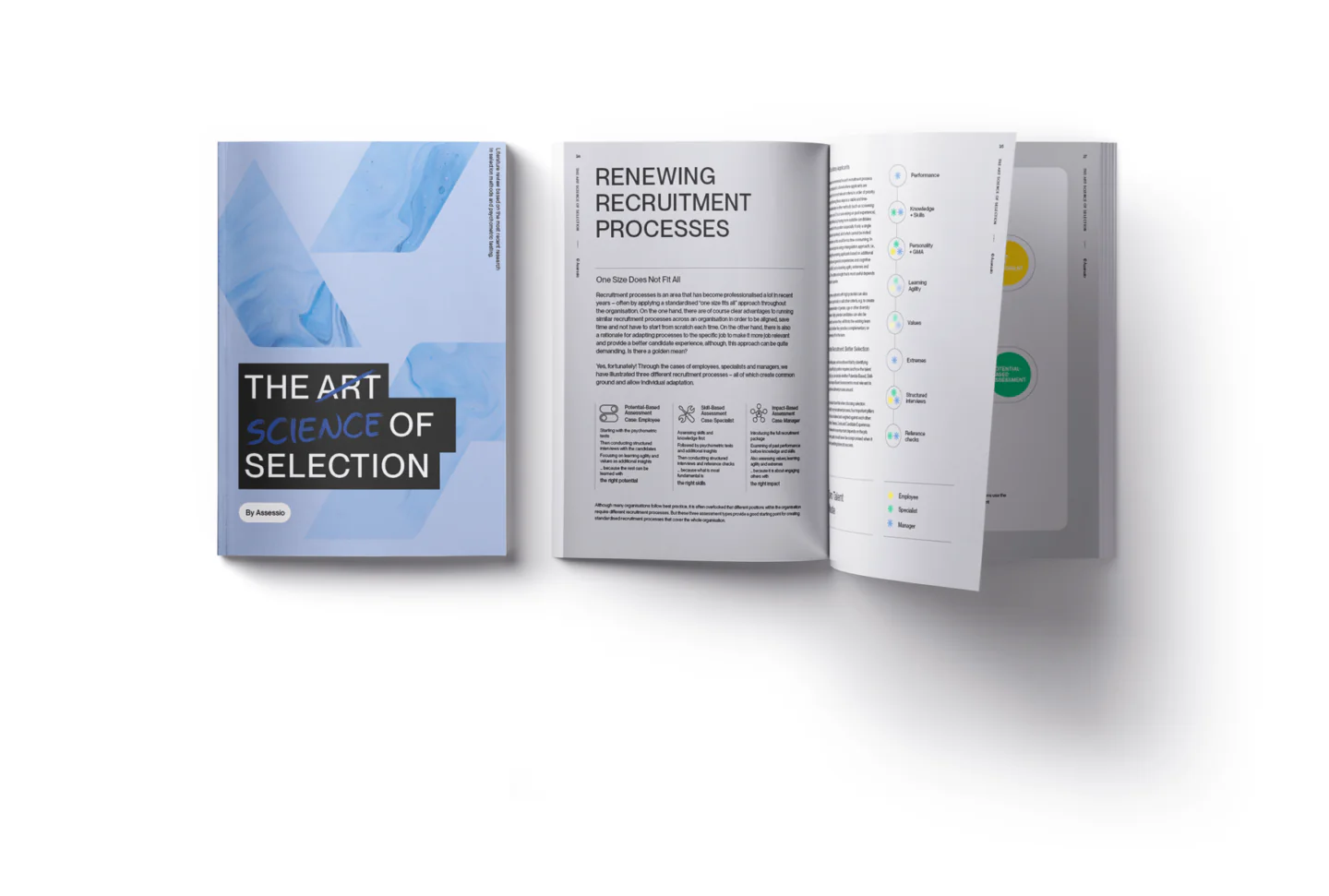Stellen Sie eine Führungskraft ein? So sieht die beste Praxis aus
Einige Funktionen prägen die Kultur, die Strategie und die Performance Ihres gesamten Unternehmens. Die Rolle der Führungskraft ist eine davon. Deshalb ist es so wichtig, sie richtig zu besetzen - zusätzlich kann es teuer werden, sie falsch zu besetzen.

Stellen Sie eine Führungskraft ein? So sieht die beste Praxis aus
Einige Funktionen prägen die Kultur, die Strategie und die Performance Ihres gesamten Unternehmens. Die Rolle der Führungskraft ist eine davon. Deshalb ist es so wichtig, sie richtig zu besetzen - zusätzlich kann es teuer werden, sie falsch zu besetzen.
Bei Assessio haben wir drei Kernfälle des Recruitments identifiziert, die unterschiedliche Ansätze erfordern: Mitarbeitende, Fachkräfte und Führungskräfte.
Während viele Unternehmen den gleichen Prozess für alle Rollen anwenden, haben wir die Erfahrung gemacht, dass der Erfolg bei der Einstellung von Mitarbeitenden deutlich steigt, wenn der Prozess auf die jeweilige Rolle zugeschnitten ist.
In diesem Artikel geht es um Führungskräfte und darum, wie Best Practices aussehen, wenn viel auf dem Spiel steht.
Es geht nicht nur um Fähigkeiten - es geht um Wirkung
Führungsaufgaben werden durch ihre Wirkung definiert. Im Gegensatz zu anderen Funktionen haben Führungskräfte Einfluss auf alles, von Engagement und Mitarbeiterbindung bis hin zu finanziellen Ergebnissen und Markenwahrnehmung. Deshalb ist es entscheidend, es richtig zu machen - und es falsch zu machen, ist kostspielig.
In den meisten Fällen ist der Pool an Bewerbenden begrenzt. Viele werden direkt angesprochen, anstatt sich über Stellenanzeigen zu bewerben. Und obwohl Fähigkeiten wichtig sind, ist Führung mehr als eine Checkliste von Erfahrungen. Deshalb ist es am besten, nicht nur zu bewerten, was die Leute wissen, sondern auch, wie sie denken, führen und sich anpassen.
"Wir haben die Erfahrung gemacht, dass sich der Einstellungserfolg deutlich verbessert, wenn der Prozess auf die jeweilige Rolle zugeschnitten ist.
Was und wie zu bewerten ist
Bei der Einstellung von Führungskräften empfehlen wir ein Assessment in sechs Schlüsseldimensionen:
- Performance: Was hat der Bewerbende erreicht und wie? Nutzen Sie strukturierte Referenzüberprüfungen und 360°-Feedback, um die bisher erbrachte Leistung zu verstehen.
- Fähigkeit: Können sie mit Komplexität umgehen? Kognitive Tests zeigen, wie Bewerbende an strategisches Denken und Entscheidungsfindung herangehen.
- Potenzial: Werden sie mit der Rolle wachsen? Persönlichkeits-Assessments helfen bei der Vorhersage der langfristigen Anpassungsfähigkeit und Führungsentwicklung.
- Risikoverhalten: Zeigen die Bewerbenden Eigenschaften, die unter Druck kontraproduktiv werden könnten?
- Werte: Stimmen die Werte mit denen Ihres Unternehmens überein?
- Passung und Kommunikation: Strukturierte Interviews bringen alles zusammen und zeigen, wie die Bewerbenden ihren Führungsstil reflektieren und kommunizieren.
Lassen Sie die Struktur nicht auf der Zielgeraden zusammenbrechen
Selbst wenn die richtigen Methoden eingesetzt werden, sind viele Einstellungsverfahren am Ende unzureichend. Die Assessments sind abgeschlossen. Die Gespräche sind abgeschlossen. Und dann wird die endgültige Entscheidung auf der Grundlage des Bauchgefühls oder desjenigen getroffen, der als erster im Raum spricht.
Das ist ein häufiger und kostspieliger Fehler, vor allem, wenn Sie sich zwischen zwei starken Bewerbenden entscheiden müssen.
Was sollten Sie also stattdessen tun?
Unser neues White Paper, The Science of Selection Methods, ist jetzt verfügbar.
Es gibt Ihnen evidenzbasierte Ratschläge, wie Sie Methoden kombinieren können, die tatsächlich funktionieren, und wie Sie die häufigsten Fehler in jeder Phase des Prozesses vermeiden können.
Außerdem erhalten Sie unsere Best-Practice-Empfehlungen für die Einstellung von Mitarbeitenden, Fach- und Führungskräften - und erfahren, wie Sie Ihren Prozess auf den jeweiligen Fall zuschneiden können.



